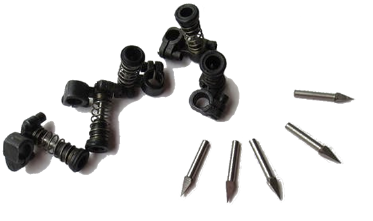
Borers are often ‘knife’ attachments which are offset from the main needle. Bevor die Stickmaschine beginnt, wird der Rahmen so bewegt, dass sich der Bohrer in der korrekten Position befindet. This movement compensates for the borer offset.
Check your machine user guide. If it is capable of boring, you may add a borer knife or needle and activate the borer function. For older Tajima models, there is a ‘Borer’ dip switch in the control panel. For newer models, there is a ‘Borer’ function among the machine settings.
Here is a standard Tajima borer set. The borer knife is mounted inside the rubber tube, and the borer set is mounted on the needle bar. On the machine, there is a hole filled with a small rubber mat to buffer the borer.

Select the format for the target machine you are using. For instance, Tajima, Barudan, SWF, Dahao, Happy, ZSK2. The needle position of the borer and its offset value are specified in the Machine Format Settings dialog as part of the machine format definition.

The default setting for Tajima and Dahao formats is for a ‘knife’ attachment, where the cutting position is offset ±12 mm from the main needle line. Diese Versetzung wird nur ausgeführt, wenn Sie Ihr Stickmuster in einem Stichformat wie DST gespeichert wird.
If you are using a boring needle instead of a knife, no offset is required. Einige Stickmaschinen führen für diese Versetzung beim Auffinden einer ‚Bohrer EIN‘-Funktion eine automatische Justierung aus. These require a value of ‘0’. This too should be part of the machine format definition, but you may need to adjust it manually. Bitte vergleichen Sie Ihr Maschinenhandbuch für Einzelheiten.
Anmerkung: Bei Tajima und Barudan Maschinen fügt der Bohrer-Befehl eine Stopp-Funktion ein, die es der Maschine ermöglicht die Nadelposition zu wechseln, die sie für die Bohrervorrichtung gebraucht. Die Maschine muss korrekt programmiert sein, so dass auch die korrekte Nadelposition verwendet wird.